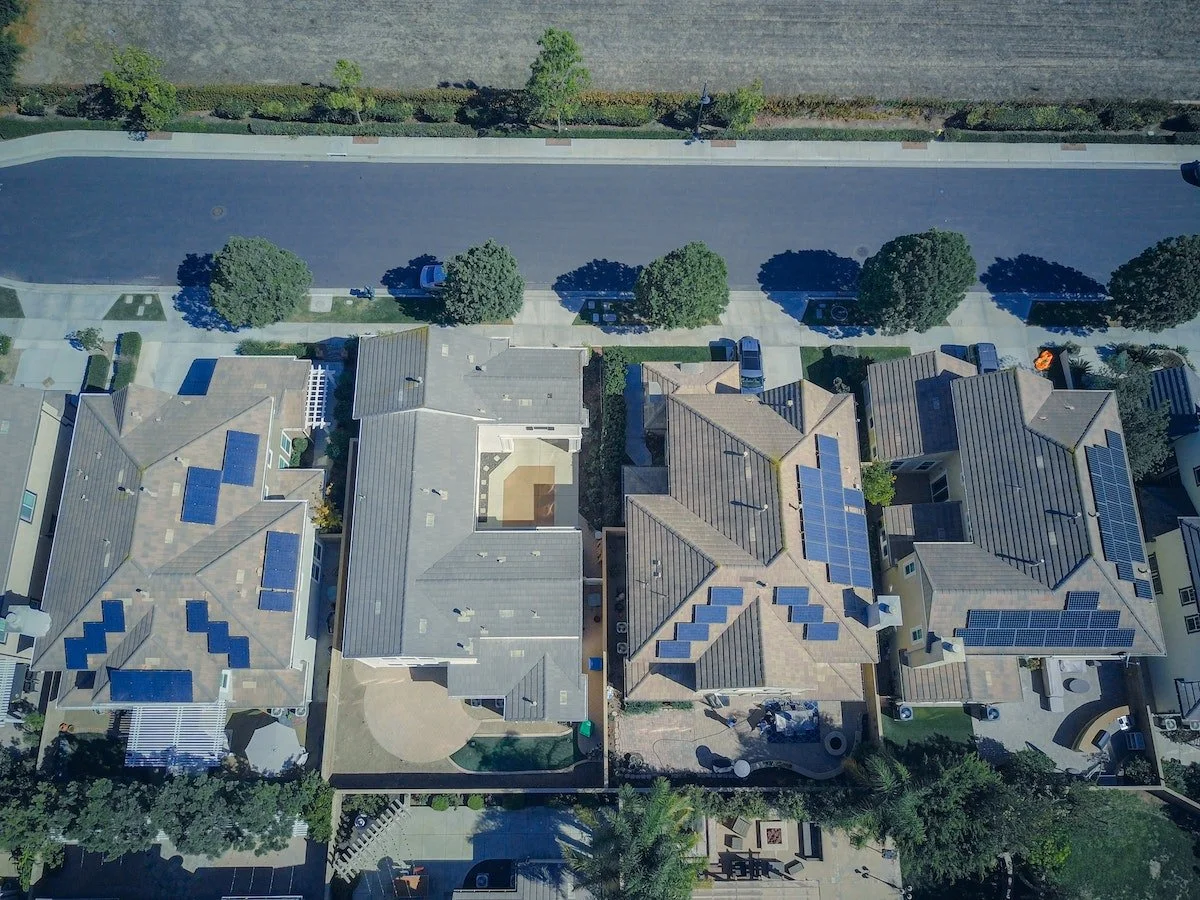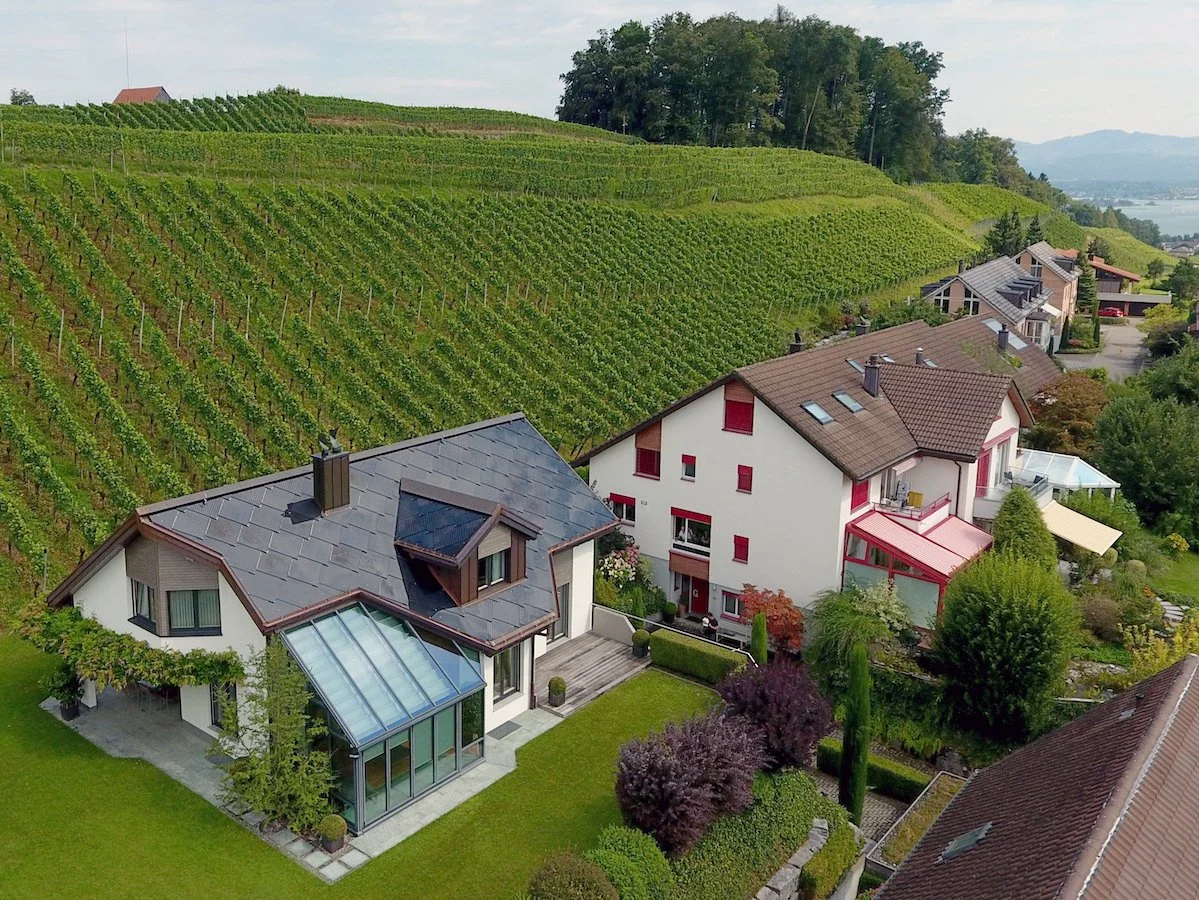In this overview, we will highlight the important points of how a photovoltaic system works and what benefits you can see as a result.
What are the solar options when building a new house?
If you look around the neighborhood, you see more solar panels being installed today than in the past. You know that these photovoltaic systems collect solar energy to generate electricity in a home, but what exactly do these systems do and what possibilities exist when building a new house?
What are photovoltaics (PV)?
Photovoltaics is the process of converting sunlight into energy using solar panels with modules to collect the sun.
When sunlight hits the cell, it is captured and it triggers a process where the electrons are set in motion. There is an interaction between the sun’s rays and a semiconductor, which creates a charge that can then be converted into usable electricity.
Since the sun is a renewable resource, we can use the photovoltaic process to reduce our dependency on fossil fuels to generate electricity. As the demand for energy continues to rise, we can all help stop climate change by installing PV systems at our homes.
What are the different PV options when building a house?
Nowadays, there are different technical solutions for generating electricity from solar energy. It makes sense to consider your options for a photovoltaic system when building a house. There are efficiencies in installing your system while in the construction phase, rather than waiting until after the construction is complete. As a result, the investment in a photovoltaic system pays for itself earlier and your energy savings will be realized from the minute you move in.
Classic photovoltaic systems
A classic photovoltaic system consists of large solar panels that are mounted on the roof. For a traditional PV system, the panels are installed after the roof decking and shingles have been installed. Depending on the layout of the roof, a solar designer will provide you with placement of the panels to maximize your solar energy system size. The solar panels cannot be placed over skylights, chimneys or vents, so the placement of the panels will vary based on the roof conditions.
If your home was recently built or you recently replaced the roof, installing a classic solar system will be the most economical solar system for you. There are a lot of different solar panel manufactures, so an installer can provide detail on the aesthetics and specifications.
Building-Integrated Photovoltatics (BIPV) as an innovative solar roofing solution
BIPV, also referred to as a solar roofing system, creates an optimal aesthetic, while still providing the benefits of a traditional PV system. When building a new house, solar shingles replace traditional shingles, so it is ideal to consider this during the planning phase of your construction. A solar designer will still outline the sunniest locations to place the active shingles, and then add inactive shingles around the remainder of the roof for the fully uniform look that many homeowners appreciate.
SunStyle specializes in building-integrated photovoltaics and offers a smart solution for renewable energy with a modern design that is preferred by homeowners and architects alike.


Under what conditions does a photovoltaic system make sense?
Photovoltaics always makes sense when your system can cover your own electricity needs, reducing the cost of your monthly electricity bill and also reducing your reliance on grid-tied energy.
With rising electricity prices and decreasing prices of PV systems, solar is becoming a mainstream solution that is included on new homes, or retrofit on existing homes. Depending on your location, there are also incentives for installing solar systems, including tax credits or rebates.
In addition, more and more people are looking to slow down climate change and make a positive impact on our environment, so a photovoltaic system is a good step in moving towards a more sustainable lifestyle.
Grid-connected or uncoupled photovoltaic system
When installing the system, it can be decided to be connected to the power grid or to install the photovoltaic system that is “off-grid”. When a system is tied to the grid, a home does not have to rely exclusively on the solar energy they produce. It also means that excess energy can be fed back into the grid for the utility companies in exchange for a credit on their utility bill. Every state has different net metering rules on the financial incentives associated with feeding excess energy back to the utility companies.
When a system is uncoupled from the power grid, the home’s electricity is 100% dependent on the energy their PV system produces. The power can be stored in a battery to be available in case the sun is not shining or to sustain power through the night.
What are the key factors to consider before purchasing a photovoltaic system?
The first step is to receive a solar energy analysis for your property. A solar designer will assist you in reviewing your home to determine your energy needs and potential system sizes. The orientation of the roof and pitch play an important role in ensuring the optimum efficiency of the system. Ideally, the roof should be south-facing and be at least a 2:12 pitch. Therefore, it makes sense to plan an installation of a photovoltaic system during the design phase of new construction, when possible.
In addition, you should consider the cost and any incentives that are available to you. Your trusted solar installation team will be able to assist you in this process to understand the total cost.
How do I find the right PV system for my house?
You should consider what type of PV system will suit your needs. If you are in the design phase of a new home or considering a new roof for your property, you should consider a BIPV solar roof. If your roof is in good condition and you are looking to add a solar system, then traditional solar panels would likely be a better option for you. A solar installation expert will be able to provide you with the projected energy output for your property, and then provide a price based on that system size.
Another important factor is the quality of the system. You should consider the specifications of your systems to ensure that the product you choose is durable and will last through the duration of your investment.
Frequently Asked Questions
Who can install a photovoltaic system?
If you are in the process of building a home, your general contractor should be able to assist you in finding a trained solar installer to assist with your project. If you are looking to re-roof an existing house or simply add solar panels, you should identify a trained solar installer in your area. Solar installers typically offer a variety of different products and can talk with you about the differences between a classic photovoltaic system and building-integrated solar options.
Is a photovoltaic system subject to approval?
Photovoltaic systems are typically subject to approval from local permitting officials. You typically need a building permit. Your solar installation team will assist you in understanding and apply for the necessary permits to comply with state building regulations. If your home is located in an area governed by a homeowners association, you may be required to obtain approval from the board, as well.
In most cases, the adoption of solar systems is welcomed and encouraged, so the permitting and approval processes move quickly.
When does photovoltaics pay for itself?
The payback period of a photovoltaic system depends on the system size and energy offset. Your solar design team can provide specific details. If you choose to install a solar roof, the payback period will appear longer, as there is a higher initial cost, however it is important to consider that you are receiving payback on the roofing material, in addition to the solar modules. With classic solar panels, there is no way return on investment from the traditional roof.
More information about estimating payback can be found in this article, How much does a solar roof cost?
How long does a photovoltaic system last?
On average, the service life of crystalline solar cells is over 30 years. However, the efficiency of the cells decreases slightly every year. This means that the electricity generation of the photovoltaic system decreases over the years, but since the system has already paid for itself after about 10 years, 20 years of additional energy savings makes solar a worthwhile investment.
Get more answers to frequently asked questions on our FAQ page.
If you are considering a building-integrated photovoltaic roof, please contact us to discuss your project.
For more information about SunStyle’s solar roof, visit sunstyle.com
Power your interest in the future of solar roofing by following us:
Instagram @sunstyle _solar
Facebook @sunstylesolar
LinkedIn linkedin.com/company/sunstylesolar
Youtube @youtube channel


